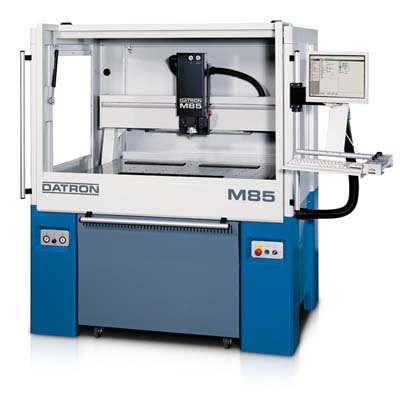
Based on their flagship, M8 high-speed machining center, Datron Dynamics Inc. has introduced the M85, featuring a 30,000 RPM spindle. This German-made machine has a concrete-polymer machining table that provides 40" x 30" work area and a 1.2kW machining spindle delivers feed rates of up to 550 ipm. Datron positions this model as an economical means of milling, drilling and engraving aluminum, plastics, stainless steel, brass, and exotic composites. The M85 is ideal for the production of panels and housings, plastic machining and 2-D or 3-D engraving in stainless steel. According to Datron Dynamics Vice President, Robert Murphy, "The M85 is based on our M8 chassis, but has a lower rpm spindle for applications that don't require the speed or accuracy of the M8. There are a number of industries that don't need all of the features of the M8, but still want Datron quality and access to unique Datron options like XYZ probing." Included with the M85 as standard features are a spray-mist coolant system, 10-station Automatic Tool Changer with tool database and tool-length sensor, Windows-based control software, PC, flat-screen monitor and hand-held remote, as well as, a full safety protective enclosure with lock out/tag out capability. M85 options include 3-D probing, integration of virtually any CAD/CAM software and a variety of integrated workholding solutions like pneumatic clamping systems and the company's VacuMate vacuum tables.
Contact Details
Related Glossary Terms
- 2-D
2-D
Way of displaying real-world objects on a flat surface, showing only height and width. This system uses only the X and Y axes.
- 3-D
3-D
Way of displaying real-world objects in a natural way by showing depth, height and width. This system uses the X, Y and Z axes.
- composites
composites
Materials composed of different elements, with one element normally embedded in another, held together by a compatible binder.
- coolant
coolant
Fluid that reduces temperature buildup at the tool/workpiece interface during machining. Normally takes the form of a liquid such as soluble or chemical mixtures (semisynthetic, synthetic) but can be pressurized air or other gas. Because of water’s ability to absorb great quantities of heat, it is widely used as a coolant and vehicle for various cutting compounds, with the water-to-compound ratio varying with the machining task. See cutting fluid; semisynthetic cutting fluid; soluble-oil cutting fluid; synthetic cutting fluid.
- feed
feed
Rate of change of position of the tool as a whole, relative to the workpiece while cutting.
- gang cutting ( milling)
gang cutting ( milling)
Machining with several cutters mounted on a single arbor, generally for simultaneous cutting.
- inches per minute ( ipm)
inches per minute ( ipm)
Value that refers to how far the workpiece or cutter advances linearly in 1 minute, defined as: ipm = ipt 5 number of effective teeth 5 rpm. Also known as the table feed or machine feed.
- machining center
machining center
CNC machine tool capable of drilling, reaming, tapping, milling and boring. Normally comes with an automatic toolchanger. See automatic toolchanger.
- milling
milling
Machining operation in which metal or other material is removed by applying power to a rotating cutter. In vertical milling, the cutting tool is mounted vertically on the spindle. In horizontal milling, the cutting tool is mounted horizontally, either directly on the spindle or on an arbor. Horizontal milling is further broken down into conventional milling, where the cutter rotates opposite the direction of feed, or “up” into the workpiece; and climb milling, where the cutter rotates in the direction of feed, or “down” into the workpiece. Milling operations include plane or surface milling, endmilling, facemilling, angle milling, form milling and profiling.






